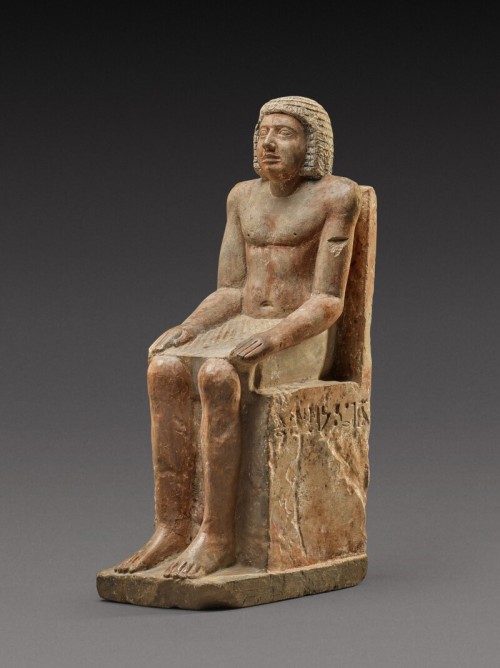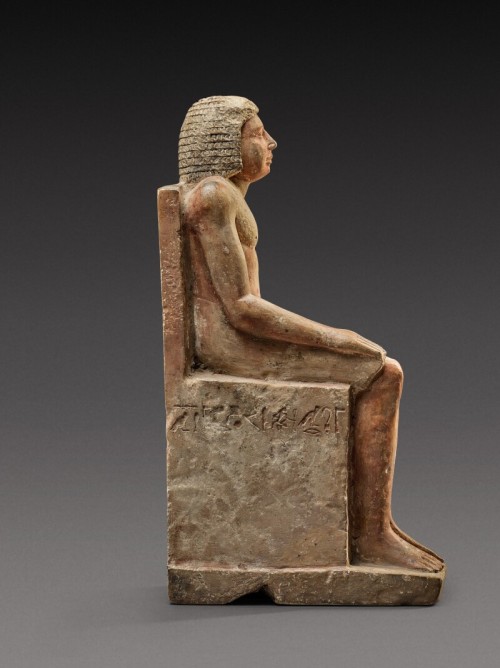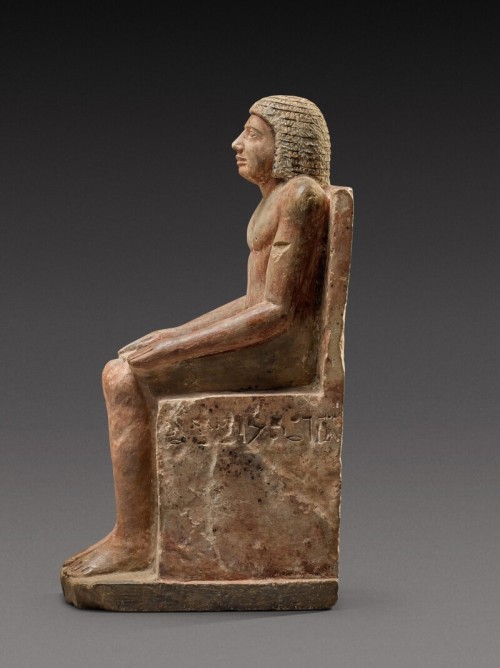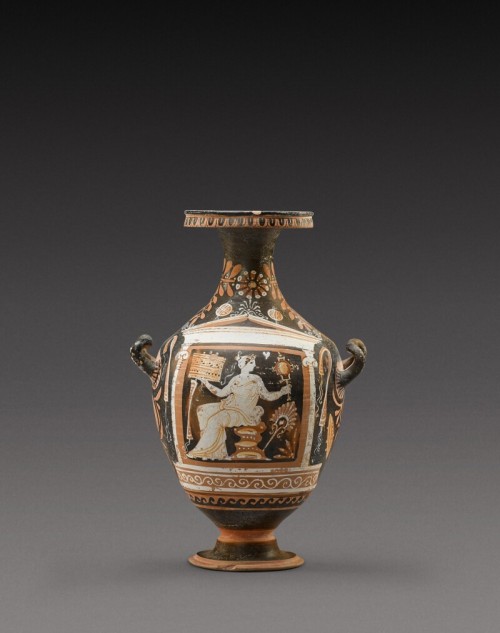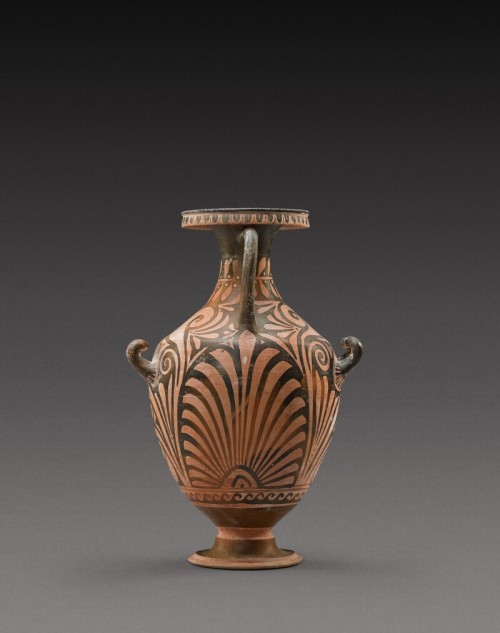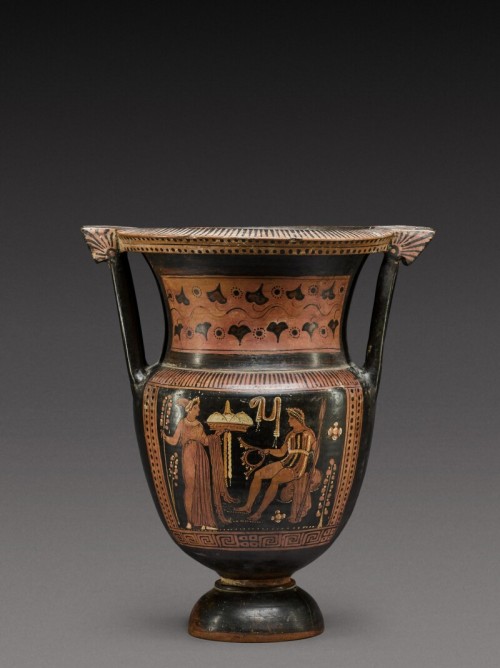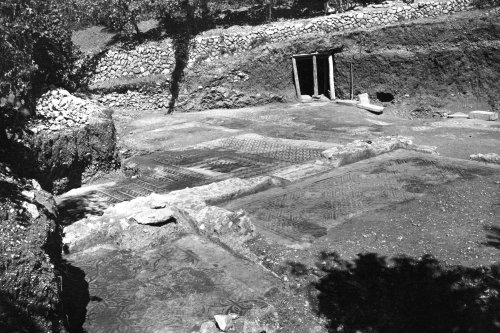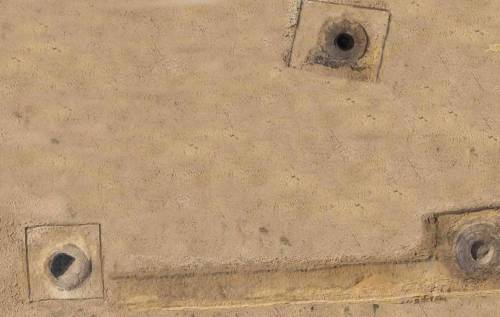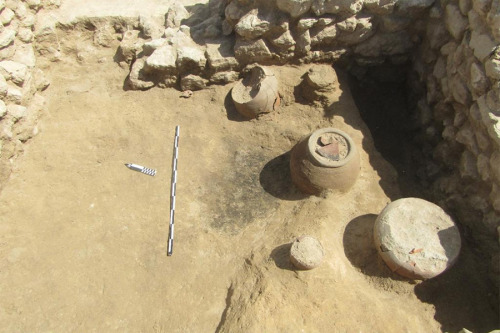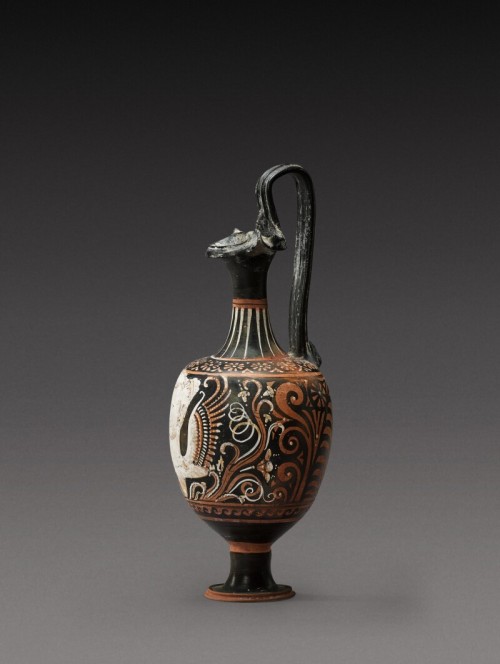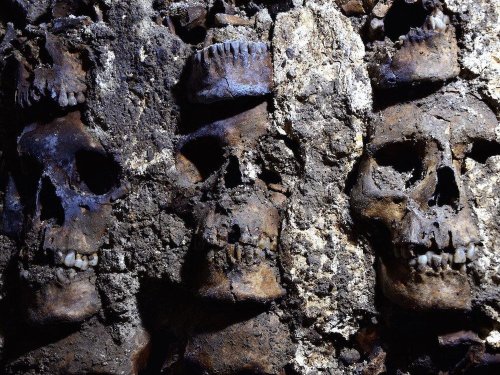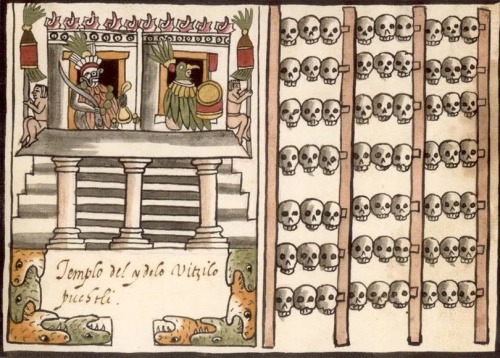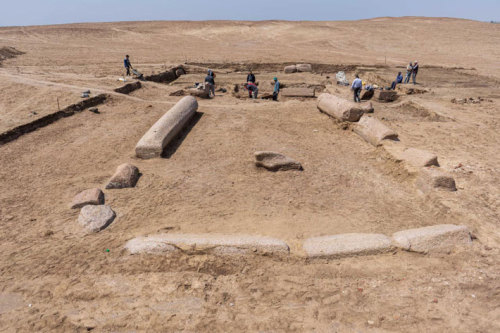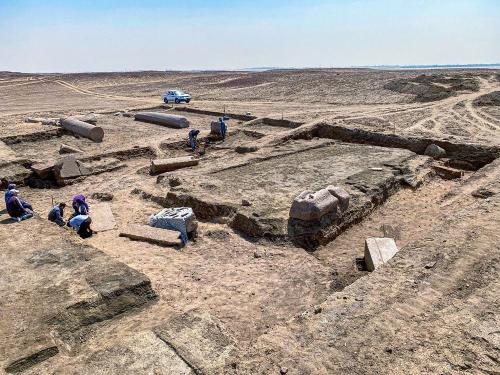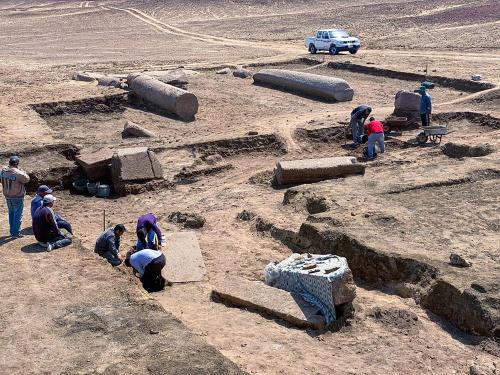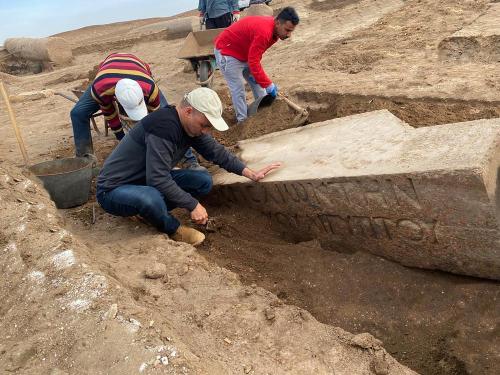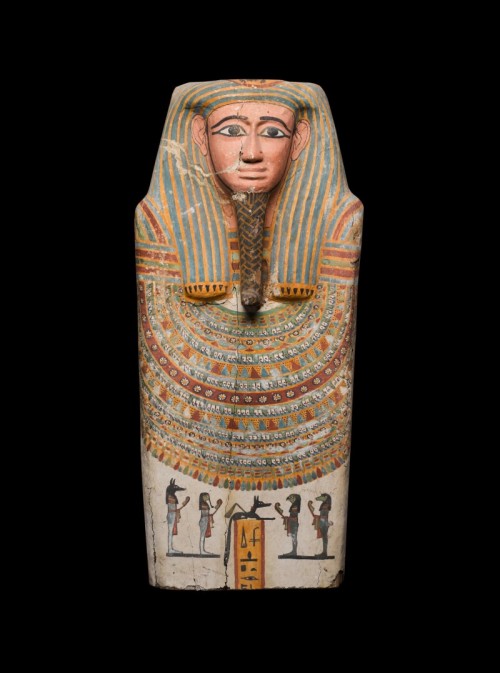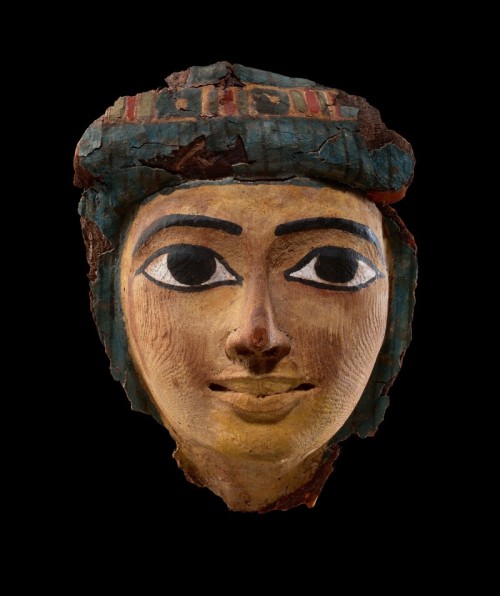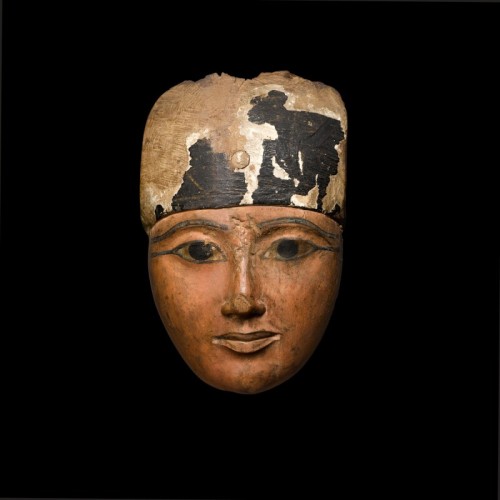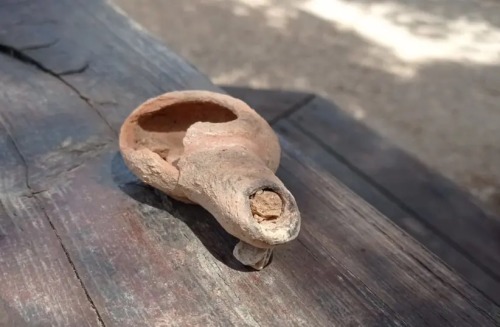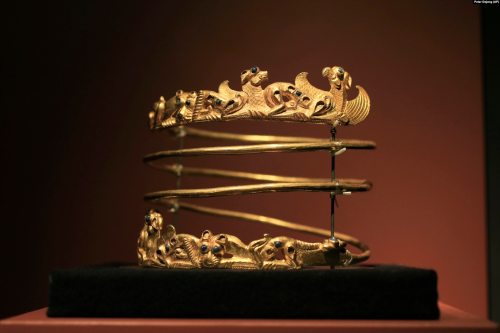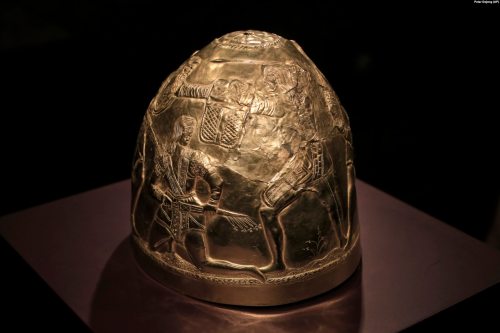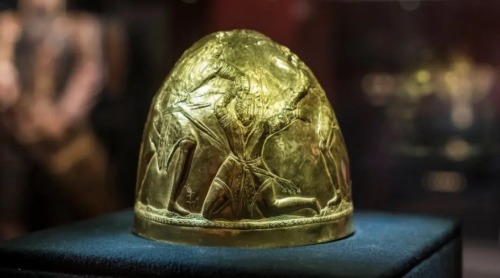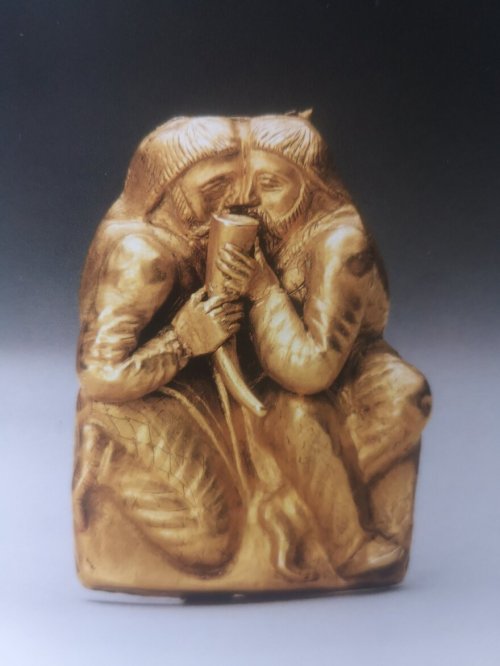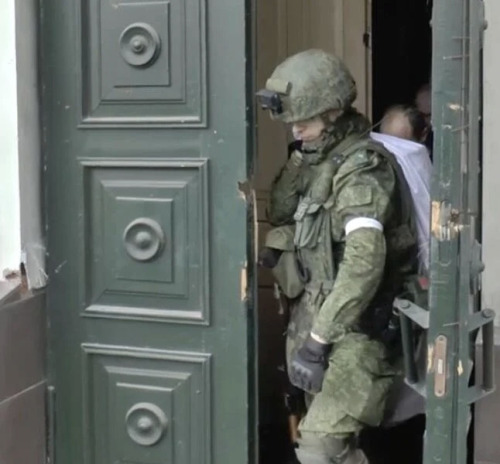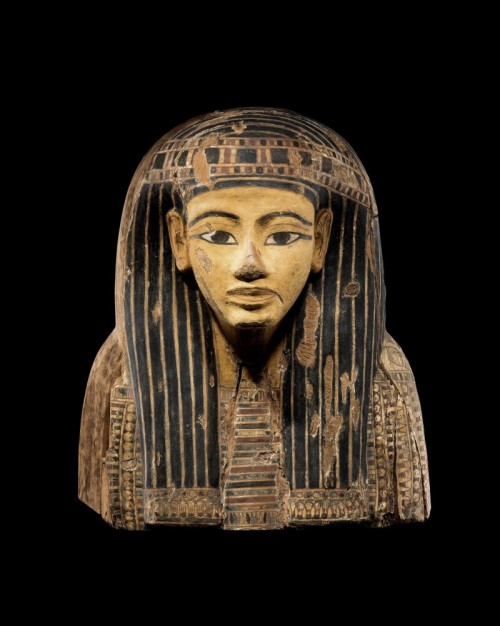#history news
An Egyptian Polychrome Limestone Figure of Hem-Min
6th Dynasty, 2360-2195 B.C.
Inscribed “Treasurer of the God, Overseer of the Army, Overseer of the Prospectors, revered with the God,” seated on a high-backed chair inscribed on both sides with his names and titles, his hands resting on his knees, and wearing a short pleated kilt and wig of layered trapezoidal curls, his face with prominent chin, outlined lips, and slightly aquiline nose; remains of red pigment on the body and black pigment on the wig.
Height 48.3 cm.
Post link
An Apulian Red-figured Hydria
Circa 350-330 B.C.
Painted with a woman seated within a naiskos and holding a mirror and a casket, the details in added white and yellow.
Height 43 cm.
Sold: 5,040 GBP 12/2020
Post link
An Apulian Red-figured Column Krater, attributed to the Painter of the Truro Pelike.
Circa 350-330 B.C.
Painted in front with a standing woman and a seated youth, and on the back with two youths flanking a plant, the details in added white and yellow.
Height 44.2 cm.
Sold: 6,930 GBP 12/2020
Post link
Sixth-Century A.D. Mosaic Unearthed in Italy
A section of mosaic flooring from the 5th century palace of Ostrogoth king Theodoric has been discovered in Verona. The mosaic was found during installation of new gas pipes in the Montorio hamlet less than four miles from Verona’s historic town center.
Remains of an enormous country villa more than five acres in surface area have been turning up in Montorio since the 19th century. While there is no direct evidence that it was one Theodoric’s many palaces, the sheer size and scale strongly suggests it was a royal estate. If it wasn’t Theodoric’s palace, it must have belonged to someone of enormous wealth who was very close to him.
Theodoric was not technically a Roman emperor. He was three different varieties of king, though, starting in 475 A.D. as King of the Ostrogoths, then adding King of Italy in 493 and of the Visigoths in 511. By the time of his death in 526, Theodoric reigned over most of what had been the Western Roman Empire. He spent his childhood as a noble hostage at the imperial court in Constantinople and was educated there in the Eastern Roman tradition.
As ruler of a territory stretching from the Atlantic to the Danube, Theodoric embraced the ancient imperial trappings. He donned the purple, accepted the regalia of the Western Empire from Eastern Emperor Anastasius I Dicorus and allowed all Roman citizens in the kingdom to be governed by Roman judicial law. He instituted a vast program of reconstruction of Roman cities and infrastructure, restoring ancient aqueducts, baths, churches, the Aurelian walls of Rome and the defensive walls of a myriad other cities in Italy. He threw in a few new palaces for himself while he was at it, most famously in his capital of Ravenna, but also in other northern Italian cities like Verona.
The mosaic will remain in situ. It will be cleaned and documented in detail before being reburied. Some local residents have proposed covering it with plexiglass so the mosaic can still be seen, something that has been done already in Verona’s historic center, but this mosaic is in a terribly awkward position, trapped under networks of old pipes surrounded by homes, so it’s not a good candidate for display, unfortunately.
Post link
A Rare Shiva Linga Found in India
A group of workers laying the foundation for a house on a piece of land owned by a dairy farmer in Thuthipattu village near Ambur in Tirupattur unearthed a 500-year-old shiva linga.
A lingam sometimes referred to as linga or Shiva linga, is an abstract or aniconic representation of the Hindu god Shiva in Shaivism.
A team of officials from the Government Museum, Vellore, led by curator K. Saravanan, inspected the linga on Saturday and traced its origin to the later Vijayanagara era in the 16th Century. “We found a similar green stone lingam on a house plot at Arani [in Tiruvannamalai district] a decade-and-a-half ago,” Mr. Saravanan said.
To build a small concrete house for farmer S. Ramesh, workers were deepening a portion of the land to lay the foundation when one of them struck a stone idol at a depth of seven feet. Workers alerted the landlord, who informed the police and the village administrative officer.
The workers lifted the stone idol with a mechanised crane in the presence of revenue officials and the police. The shiva linga, which is two feet tall and 1.5 feet wide, has no damage to its structure.
Officials said that under the Indian Treasure Trove Act, 1878, anything found below a one-foot depth belongs to the government. Such treasure should be handed over to the district treasury, with the Collector being the sole guardian.
In this case, a report from the Government Museum, Vellore, will be sent to the Director of Museums, Chennai, and the Tirupattur Collector. Museum officials said the Collector would be requested to display the linga at Vellore Museum for students and others learn the rich past of the region.
The shiva linga, archaeologists said, would be around 500 years old and belonged to the Vijayanagara era because it was during that period, the region witnessed more temple constructions. Furthermore, most of the sculptures and idols in the region, including idols that adore the Jalakanteshwara temple, an ASI- protected monument in Vellore, belong to this period, and are made of green stones found in abundance along the Jawadhu Hills in Tiruvannamalai.
Like Sriperumbudur (the birthplace of Saint Ramanuja), the region along the Palar was a great centre for both Vaishnavites and Shaivaites. The green stone linga found near Ambur is a detachable one, another feature of the era. With the finding of the linga, the area has been earmarked for excavation, officials said.
Post link
Egypt Announces Discovery of Five Ancient Water Wells in North Sinai
An Egyptian archaeological mission working in the Tell El Kedwa region of North Sinai has discovered five water wells believed to be from the 13th century BC.
The Egyptian Antiquities Ministry said that wells were built before the reign of Seti I (1292-1190BC), but it did not give an exact date.
They are believed to have been a part of the expansive Horus Military Road, an ancient route that was used by pharaohs, the ministry said.
The wells were found outside the walls of the Tell El Kedwa fortress, one of several massive strongholds found in the area, which were used as military control points to protect Egypt’s eastern frontier and guard access to its northern regions.
The mission’s leader, Ramadan Helmy, said that four of the discovered wells were reportedly filled with sand to prevent the Persian army, which invaded Egypt in 525BC, from obtaining water.
The fifth well, which was unfilled, was a little more than three metres deep, the ministry’s said.
Inside it, the mission found 13 pottery rings and several clay pots dating back to the 26th dynasty of ancient Egypt (664–525BC), also known as the Saite period.
The fifth well was built in a haphazard manner, which was incongruent with the style of that period, Mr Helmy said.
The ministry said the mission’s excavations were part of a larger national project to develop the province of North Sinai, which contains prominent pharaonic sites that will soon be open to tourists.
Another archaeological team operating at the nearby Tell El Kedwa fortress discovered a large storage centre dating to the Saite period.
Inside the large chamber, the mission found a pile of clay pots. And within the walls of the fortress, the mission found the remains of kilns, also from the Saite period.
The kilns are were part of a large copper-smelting workshop, the ministry’s said. Copper shards were also found near the kilns.
The Horus Military Route was used during the old, middle and new kingdoms of ancient Egypt and was depicted in inscriptions at some of Egypt’s other prominent archaeological sites, including Luxor’s Karnak Temple.
At its peak, the route measured 220 kilometres and connected Egypt to Palestine.
By Kamal Tabikha.
Post link
Ancient Greek Pottery Workshop and Storage Facility Discovered in Alexandria
An Egyptian archaeological mission uncovered an Ancient Greek pottery workshop and a storage building at Tabet Al-Motaweh area to the west of Alexandria.
Mostafa Waziri, secretary-general of the Supreme Council of Antiquities, said a collection of kilns were discovered in the workshop, including two engraved in rocks, according to Ahram.
The first has a vaulted entrance through which workers passed to line up amphora in rows. The entrance is covered with clay and fragments.
Studies revealed the workshop was used throughout different periods. The northern side was used as a kiln for cement during the Byzantine time.
It was completely destroyed during the Middle Ages and converted into a cemetery. Inside one of the kilns a burial for a pregnant woman was uncovered.
Ayman Ashmawi, head of the Ancient Egyptian Antiquities Sector, said a storage was also unearthed containing a large collection of clay pots used for cooking.
The storage building comprised dorms for workers during the Ptolemaic era. It has 13 chambers, including one for religious rituals and prayers, another used as a kitchen, and a third for selling pots.
Inside the cooking pots bones of cattle and fish were found.
A large collection of Ptolemaic coins bearing the faces of Alexander the Great, deity Zeus and Queen Cleopatra were found on the floor of one of the chambers, while two large terracotta statues for deity Harpocrates and a yet unknown king in a very bad conservation condition were discovered in another chamber.
Hunting hooks and deity statues were found along with 100 catacombs.
Post link
Couple Found 1950s McDonald’s Bag with French Fries Inside Wall During Home Renovations
Cold french fries are bad enough. But cold, old french fries are even worse.
That’s the surprise from Ronald McDonald that one Illinois couple stumbled upon during home renovations.
On April 16, Rob and Gracie Jones were doing work on their 1959 Crystal Lake home, located about 50 miles northwest of Chicago.
Suddenly, they found a decades-old McDonald’s bag behind one wall.
“Rob was in the bathroom replacing the old toilet paper fixture,” Gracie said Wednesday, “As he pulled the fixture out, he noticed a rolled up piece of cloth bunched up inside the wall.”
The couple had no idea they were about to discover decades-old fast food.
“At this point we’re both looking at each other wondering if we’d be calling the police because we just uncovered evidence from a crime scene!” Gracie said, “We were very relieved to have just found the old McDonald’s bag.”
They then took the bag into their kitchen to carefully open it. Inside they found two hamburger wrappers and some half-eaten, decades-old french fries – that were crispy and brown.
The fries in the bag, which the couple may sell the right buyer.
“We saw the fries and were like, ‘This is unreal.’ How on Earth are these fries still in this bag and how are they preserved so well?! It was wild,” Gracie added.
McDonald’s fries are usually known for their salty scent, but the couple said there was no smell to these relics.
Gracie said they picked up a few of the fries and were surprised at how sturdy they were, despite their decrepit appearance.
Researching the logo on the bag they discovered, the couple learned it was used in McDonald’s production from 1955 to 1961.
They also found out that one of the area’s original McDonald’s was built down the street from their home in 1959 – the same year their house was built.
The bag even contained the original mascot for the fast-food chain, Speedee.
For now, the couple has the ancient meal in storage and aren’t sure what to do with it.
“We’d be happy to sell it or if not, we’d probably keep it as a cool piece of history,” Gracie said.
By Sara Smart.
Post link
A Roman Geometric Mosaic Panel
Circa 4th/5th Century A.D.
Centering a large lozenge design and composed of multi-colored tesserae.
121 x 201.5 x 2.5 cm
Sold: 44,100 GBP 12/2020
Post link
An Apulian Red-figured Oinochoe
Circa 330-310 B.C.
With high strap handle, the body painted with the winged head of a woman flanked by scrolling tendrils, the details in added red, yellow and white.
Height 45 cm.
Sold: 2,142 GBP 12/2020
Post link
Aztecs Constructed Tower Made Out of Hundreds of Human Skulls Discovered
Researchers in Mexico City recently discovered a new section of a macabre late 15th-century structure.
Archaeologists excavating a famed Aztec “tower of skulls” in Mexico City have uncovered a new section featuring 119 human skulls. The find brings the total number of skulls featured in the late 15th-century structure, known as Huey Tzompantli, to more than 600, reports Hollie Silverman for CNN.
The tower, first discovered five years ago by archaeologists with Mexico’s National Institute of Anthropology and History (INAH), is believed to be one of seven that once stood in the Aztec capital of Tenochtitlán. It’s located near the ruins of the Templo Mayor, a 14th- and 15th-century religious center dedicated to the war god Huitzilopochtli and the rain god Tlaloc.
Found in the eastern section of the tower, the new skulls include at least three children’s craniums. Archaeologists identified the remains based on their size and the development of their teeth. Researchers had previously thought that the skulls in the structure belonged to defeated male warriors, but recent analysis suggests that some belonged to women and children, as Reuters reported in 2017.
“Although we cannot determine how many of these individuals were warriors, perhaps some were captives destined for sacrificial ceremonies,” says archaeologist Barrera Rodríguez in an INAH statement. “We do know that they were all made sacred, that is, they were turned into gifts for the gods or even personifications of the deities themselves, for which they were dressed and treated as such.”
As J. Weston Phippen wrote for the Atlantic in 2017, the Aztecs displayed victims’ skulls in smaller racks around Tenochtitlán before transferring them to the larger Huey Tzompantli structure. Bonded together with lime, the bones were organized into a “large inner-circle that raise[d] and widen[ed] in a succession of rings.”
While the tower may seem grisly to modern eyes, INAH notes that Mesoamericans viewed the ritual sacrifice that produced it as a means of keeping the gods alive and preventing the destruction of the universe.
“This vision, incomprehensible to our belief system, makes the Huey Tzompantli a building of life rather than death,” the statement says.
Archaeologists say the tower—which measures approximately 16.4 feet in diameter—was built in three stages, likely dating to the time of the Tlatoani Ahuízotl government, between 1486 and 1502. Ahuízotl, the eighth king of the Aztecs, led the empire in conquering parts of modern-day Guatemala, as well as areas along the Gulf of Mexico. During his reign, the Aztecs’ territory reached its largest size yet, with Tenochtitlán also growing significantly. Ahuízotl built the great temple of Malinalco, added a new aqueduct to serve the city and instituted a strong bureaucracy. Accounts describe the sacrifice of as many as 20,000 prisoners of war during the dedication of the new temple in 1487, though that number is disputed.
Spanish conquistadors Hernán Cortés, Bernal Díaz del Castillo and Andrés de Tapia described the Aztecs’ skull racks in writings about their conquest of the region. As J. Francisco De Anda Corral reported for El Economista in 2017, de Tapia said the Aztecs placed tens of thousands of skulls “on a very large theater made of lime and stone, and on the steps of it were many heads of the dead stuck in the lime with the teeth facing outward.”
Per the statement, Spanish invaders and their Indigenous allies destroyed parts of the towers when they occupied Tenochtitlán in the 1500s, scattering the structures’ fragments across the area.
Researchers first discovered the macabre monument in 2015, when they were restoring a building constructed on the site of the Aztec capital, according to BBC News. The cylindrical rack of skulls is located near the Metropolitan Cathedral, which was built over the ruins of the Templo Mayor between the 16th and 19th centuries.
“At every step, the Templo Mayor continues to surprise us,” says Mexican Culture Minister Alejandra Frausto in the statement. “The Huey Tzompantli is, without a doubt, one of the most impressive archaeological finds in our country in recent years.”
By Livia Gershon.
Post link
Hundreds of Burials found beneath Leicester Cathedral During Restoration
Archaeologists have uncovered more than 100 graves next to a city cathedral undergoing a £12.7m restoration.
Leicester Cathedral closed in January to allow the construction of a visitor and learning centre.
So far about 125 burials have been found, with hundreds more expected.
Teams also want to find out how long it has been a site of Christian worship.
All the remains are due to be reinterred within the cathedral grounds once the project is complete.
Matthew Morris, from the University of Leicester Archaeological Services (ULAS), said the work carried out so far was “really just preparation” with hundreds more grave sites yet to be excavated.
“We have hardly scratched the surface on this one. The footprint of the new building is quite small but it’s in the area of the graveyard that is probably one of the most densely used because of its proximity to the high altar. It is probably going to have the higher elements of the parish - one of the most in-demand areas,” he said.
Mr Morris, who led the excavation of the nearby grave site of King Richard III, said burial records showed that from about 1550 to 1850, 16,500 people were buried in the site.
“There might be 800 or 1,000 years of burial in this graveyard. It’s quite astounding,” he said.
The remains uncovered at the site will be carefully analysed by ULAS to better understand the lives of early members of the church’s congregation.
The building has only been a cathedral since the 1920s but it was always one of the more important parish churches in Leicester since at least the Norman conquest, Mr Morris said.
The original St Martin’s Church was constructed in the 12th Century but substantially rebuilt between the 14th and 16th Centuries and then again by the Victorians.
Now archaeologists hope to discover if there was a church on the site even earlier and if a more accurate date of foundation can be uncovered.
“We think the burial soil could be up to two-and-a-half metres thick and then there could be Roman archaeology under that… we know there is a Roman building under the cathedral tower.
"One of the big questions is going to be what is underneath the graveyard? We also hope it will help us date the origin of the church. It might give us this important beginning date,” Mr Morris said.
By Ben Truslove.
Post link
Ruins of Ancient Temple of Zeus Unearthed in Egypt
Egyptian archaeologists unearthed the ruins of a temple for the ancient Greek god Zeus in the Sinai Peninsula, antiquities authorities said Monday.
The Tourism and Antiquities Ministry said in a statement the temple ruins were found in the Tell el-Farma archaeological site in northwestern Sinai.
Tell el-Farma, also known by its ancient name Pelusium, dates back to the late Pharaonic period and was also used during Greco-Roman and Byzantine times. There are also remains dating to the Christian and early Islamic periods.
Mostafa Waziri, secretary-general of Egypt’s Supreme Council of Antiquities, said archaeologists excavated the temple ruins through its entrance gate, where two huge fallen granite columns were visible. The gate was destroyed in a powerful earthquake in ancient times, he said.
Waziri said the ruins were found between the Pelusium Fort and a memorial church at the site. Archaeologists found a set of granite blocks probably used to build a staircase for worshipers to reach the temple.
Excavations at the area date back to early 1900 when French Egyptologist Jean Clédat found ancient Greek inscriptions that showed the existence of the Zeus-Kasios temple but he didn’t unearth it, according to the ministry.
Zeus-Kasios is a conflation of Zeus, the God of the sky in ancient Greek mythology, and Mount Kasios in Syria, where Zeus once worshipped.
Hisham Hussein, the director of Sinai archaeological sites, said inscriptions found in the area show that Roman Emperor Hadrian (117-138) renovated the temple.
He said experts will study the unearthed blocks and do a photogrammetry survey to help determine the architectural design of the temple.
The temple ruins are the latest in a series of ancient discoveries Egypt has touted in the past couple of years in the hope of attracting more tourists.
The tourism industry has been reeling from the political turmoil following the 2011 popular uprising that toppled longtime autocrat Hosni Mubarak. The sector was also dealt further blows by the coronavirus pandemic and most recently Russia’s invasion of Ukraine.
Post link
A Greek Marble Figure of Aphrodite with Eros
Late 4th Century B.C.
Standing with the weight on her right leg, her right arm lowered and left elbow resting on a tree trunk, and wearing a chiton bound under the breasts and around the shoulders and himation draped around the lower body and left arm, winged Eros with crossed legs, leaning against her right leg; no restorations.
Height 45.7 cm.
Sold: 20,160 GBP 12/2020
Post link
A Roman Marble Candelabrum Finial
Circa 1st Century A.D.
With spiral fluted shaft and artichoke-like terminal with overlapping leaves.
Height 42 cm.
Sold: 6,930 GBP
Post link
The Black Arrow was Britain’s first, and as of now only, orbital rocket. The rocket flew 4 times, successfully orbiting the Prospero satellite on its final flight in 1971.
The only remaining flight worthy Black Arrow is now on display at The Science Museum in London.
Post link
The NERVA was a prototype rocket engine built to test the viability of nuclear engines in spaceflight. The test program was so successful that NASA cleared the engine for flight. The engine unfortunately never flew to space as NERVA ended due to budget cuts in 1973.
Post link
The Upper Part of an Egyptian Polychrome Wood Coffin Cover
25th/26th Dynasty, 750-525 B.C.
Wearing a broad beaded and foliate collar, long braided beard with curled tip, and striped tripartite wig, the column of inscription in front surmounted by couchant Anubis, and flanked by the Four Sons of Horus.
Height 110 cm.
Sold: 16,380 GBP 12/2020
Post link
An Egyptian Polychrome Wood Mummy Mask
21st/22nd Dynasty, 1075-716 B.C.
The oval face with full outlined lips deeply indented at the corners, large wide-set eyes, and fragmentary striped blue wig with diadem.
Height 20.5 cm.
Post link
An Egyptian Polychrome Wood Mask
22nd/24th Dynasty, 944-716 B.C.
With broad oval face, bow-shaped mouth with finely outlined lips, straight nose, and almond-shaped eyes with long eyebrows and cosmetic lines painted in black, the remaining central portion of the wig with tenon for attachment.
Height 20.3 cm.
Post link
Ancient Samaritan Oil Lamp Discovered During Work on Mount Gerizim
The lamp was discovered while workers were clearing out an area around the stone bath from debris by hand.
A nearly completely intact clay oil lamp from 2,300 years ago was found near a stone bath during recent conservation work at the Mount Gerizim National Park.
“It is great to find something even after all those years of excavation,” said Netanel Elimelech, director of the park run by the Israel Nature and Parks Authority. “We found a lot of clay sherds lying around, but to find something complete with signs of its use is pretty nice. You can still see the black marks of burning from when the lamp was used. It throws you back (in time.)”
The archaeological complex on Mount Gerizim, located outside of Nablus, was excavated in the 1990s under the leadership of archaeologist Dr. Yitzhak Magen. Recently conservation and accessibility work has been undertaken by the Nature and Parks Authority and the Civil Administration.
The lamp was discovered while workers were clearing out an area around the stone bath from debris by hand, said Elimelech.
“We were clearing real close to the surface and the lamp just popped out,” he said.
The stone bath is believed to have been used for purification and cleansing by the Samaritans. Unlike a Jewish mikveh, the Samaritan bath is an actual element that, though heavy, can be moved.
The archaeological site on the Mount of Blessing at the top of Mount Gerizim spreads over 400 dunams. It includes remains from a large Samaritan city from the Persian-Hellenistic period which was built around a scared precinct. The precinct was surrounded by a well-fortified wall and in the center stood the Samaritan Temple. Remains of a large building containing dozens of rooms were previously excavated south of the sacred precinct. Within this structure is an olive press, a splendid residential building and shops.
The lamp, which is typical of its period, was found in the residential building. Other evidence of daily life such as plates, pots and vases, had also been previously excavated in the residence which archaeologists believe belonged to a family of wealthy priests, said Elimelech.
The Samaritans are mentioned in the Bible and view themselves as descendants of the Northern Israelite tribes of Ephraim, Menasseh and Levi, who survived the destruction of the Kingdom of Israel by the Assyrians in 722 BCE. Today members of the tiny sect who number in the hundreds live in two locations, on Mount Gerizim and in the Israeli city of Holon.
According to the Samaritan tradition, God chose Mount Gerizim for the location of the Temple, rather than Mount Moriah in Jerusalem, and it is here where God told Abraham to sacrifice Isaac.
By Judith Sudilovsky.
Post link
Russians Looted Priceless Artifacts From Museums in Mariupol and Melitopol
The heist started when a mysterious man in a white lab coat showed up at the museum.
A squad of Russian soldiers stood behind him, with guns, watching eagerly.
Using long tweezers and special gloves, the man in the white coat carefully extracted scores of special gold artifacts more than 2,300 years old from cardboard boxes in the cellar of a museum in Melitopol, a southern town in Russian-occupied territory, Ukrainian officials said. The gold items were from the Scythian empire and dated back to the fourth century B.C.
Then the mysterious expert, the Russian soldiers and the gold disappeared.
“The orcs have taken hold of our Scythian gold,” declared Melitopol’s mayor, Ivan Fyodorov, using a derogatory term many Ukrainians reserve for Russian soldiers. “This is one of the largest and most expensive collections in Ukraine, and today we don’t know where they took it.”
This was hardly the first attack on Ukrainian culture since the war began.
In Mariupol, the town that has been hammered for weeks by Russian forces, officials said that Russian agents broke into an art museum and stole masterpiece paintings, a famous sculpture and several highly valued Christian icons.
Across Ukraine, officials said, dozens of Orthodox churches, national monuments and cultural heritage sites have been destroyed. In one town near Kyiv, Borodianka, Russian soldiers shot the bust of a famous Ukrainian poet in the head.
On Saturday, Ukrainian officials said that more than 250 cultural institutions had been damaged or destroyed.
But perhaps no cultural heist has been as brazen as what unfolded in Melitopol just a few days ago.
According to Leila Ibrahimova, the director of the Melitopol Museum of Local History, the trouble started in late February, when Russian forces shelled the airport and took over the city. Soldiers went on a rampage, smashing into supermarkets, stores and homes.
Most of the city’s residents hid inside their houses. But a few museum workers, including Ms. Ibrahimova, made their way back to the museum.
It is an elegant, three-story, stone building in the old part of town, home to 50,000 exhibits, from Soviet-era medals to old battle axes. But its prized collection was a set of rare gold ornaments from the Scythians, a nomadic people that founded a rich, powerful empire, centered in the Crimean Peninsula, that endured from around the eighth century B.C. to the second century A.D.
It was the Scythian gold that Ms. Ibrahimova was most worried about.
She and other staff members secretly hid it and some other historic artifacts in cardboard boxes, stashing the boxes in a dank cellar where they didn’t think anyone would find it.
“We knew that any second someone could come into the museum with a weapon,” she said. So they worked fast, she said, because “the collection is priceless.”
In mid-March, Ms. Ibrahimova said Russian troops burst into her house with assault rifles, threw a black hood over her head and kidnapped her. After several hours of intense questioning, they let her go. Two weeks later she left Melitopol for an area not under Russian control.
But on Wednesday, she received a call from a caretaker at the museum. The caretaker said Russian soldiers, along with intelligence officers and a Russian-speaking man in a white lab coat, had come to her house in the morning and ordered her, at gunpoint, to go with them to the museum.
They commanded her to take them to the Scythian gold.
The caretaker refused, Ms. Ibrahimova said. But the man in the white coat found the boxes anyway with the help of a Ukrainian, Evgeny Gorlachev, who was appointed by the Russian military as the museum’s new director, she said. A Russian crew filmed part of the robbery.
“We hid everything but somehow they found it,” she said.
What was stolen: at least 198 gold items, including ornaments in the form of flowers; gold plates; rare old weapons; 300-year-old silver coins; and special medals. She said many of the gold artifacts had been given to the Scythians by the Greeks.
In an interview on Russian television, Mr. Gorlachev said the gold artifacts “are of great cultural value for the entire former Soviet Union” and that the previous administrators of the museum “spent a lot of effort and energy” to hide them.
“For what purpose, no one knows,” he said. “But thanks to these people and the operational work carried out, residents of the city of Melitopol — and not only Melitopol — will be able to observe again a large collection of Scythian gold.” He did not say when or where the artifacts would be displayed.
Ms. Ibrahimova, who spoke by phone, sounded despondent as she spoke about the Russian invaders.
“Maybe culture is the enemy for them,” she said. “They said that Ukraine has no state, no history. They just want to destroy our country. I hope they will not succeed.”
Scythian gold has enormous symbolic value in Ukraine. Other collections of the artifacts had been stored in vaults in the capital, Kyiv, before the war broke out. But Ms. Ibrahimova said events unfolded too fast for her museum to spirit out their collection.
For years now, Ukraine has been locked in a complicated dispute with Russia over collections of Scythian gold that several museums in Crimea had lent to a museum in Amsterdam. After Russia seized Crimea in 2014, Ukraine pleaded with the Amsterdam museum not to return the gold. Russia demanded the museum do just that. A court has ruled in Ukraine’s favor and the gold remains in Amsterdam.
But historians said the looting of the artifacts in Melitopol is an even more egregious attempt to appropriate, and perhaps destroy, Ukraine’s cultural heritage.
“The Russians are making a war without rules,” said Oleksandr Symonenko, a fellow of Ukraine’s Archaeology Institute and a Scythian specialist. “This is not a war. It is destroying our life, our nature, our culture, our industry, everything. This is a crime.”
The caretaker who refused to help the Russians was released on Wednesday after the gold was stolen. But on Friday she was taken away from her house at gunpoint again, Ms. Ibrahimova said, shortly after the mayor, who is also in exile, announced the theft.
She has not been heard from since.
By Jeffrey Gettleman and Oleksandr Chubko.
Post link
The Upper Part of an Egyptian Polychrome Wood Sarcophagus
21st/early 22nd Dynasty, circa 1075-950 B.C.
Wearing a broad collar, and striped tripartite wig with diadem and friezes of uraei at the ends of the lappets, the face with full outlined lips and long eyebrows and cosmetic lines, fine red lines delineating the folds of the upper lids.
Height 57 cm.
Post link
An Egyptian Encaustic on Wood Mummy Portrait of a Youth
Circa late 1st Century A.D.
Wearing a white tunic with red clavus and white mantle, his dark curly hair with a youthful ringlet beneath the right ear and surmounted by a foliate wreath.
31.4 by 15.2 cm.
Sold: 23,940 GBP 12/-2020
Post link


